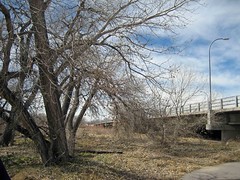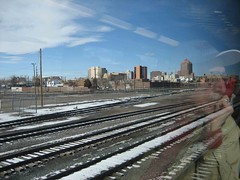It’s too early yet (Feb. 25, 2007) for the cottonwoods to be leafing out, but it seems worthwhile for phenological purposes to note when things aren’t happening as well as when they are – to sort of bracket the phenomenon. This is from a nice midday bike ride with Miguel, down around the junk yard loop. It was taken where the bike trail goes under the Bridge Boulevard bridge. I like it that Albuquerque has a Bridge bridge.
Two weeks ago, there were cranes aplenty in the fields down at the Old Schwartzman farm, but we didn’t see any today. That’s one of the clues that we’re on the cusp of spring – cranes gone, cottonwoods not yet ready to go, temperatures up in the mid-40s (~7 C), that middle ground where I’m not quite comfortable shedding the winter cycling gear, but then I end up zipping and unzipping the jacket and switching back and forth between heavy and light gloves, trying to get comfy.
Not that I’m complaining. It was a lovely ride.




